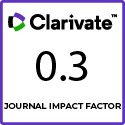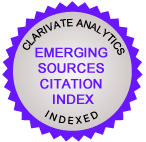The public square as an innovative place for scientific divulgation: Vila da Ciência project
-
Verbena Córdula Almeida
 vcalmeida@uesc.br
vcalmeida@uesc.br
-
Lisandro Diego Giraldez Alvarez
 giraldezli@gmail.com
giraldezli@gmail.com
Downloads
DOI:
https://doi.org/10.4067/S0718-48672019000100117Abstract
Despite the fact that 61% of the Brazilian population is interested in Science, the Brazilian State does not show any interest in these facts if we analyze the budget cuts that the sector is suffering during the last years. However, the academic and scientific community carries out scientific dissemination actions with the aim of bringing science closer to society. Thus, the Departamento de Ciências e Tecnologías (DCT) of the Universidade Estadual do Sudoeste de Bahia (UESB) has developed the university extension project called Vila da Ciência (in Portuguese), which, in addition to collaborating with Projects in Chemistry, Biology, Mathematics and Physics, offers cycles of conferences that are presented in different schools, mainly public, and private. These are talks presented by students and professors of the UESB postgraduate courses about their research and using a language appropriate to the young people of the institutions that request it. The main focus is oriented towards public schools because it is in them where those responsible for the project noticed the highest rate of rejection of the study of Sciences. In order to democratize the access to scientific and technological knowledge, as well as to bring the University closer to society, one of the most innovative initiatives of the project is the realization of the event called Vila da Ciência which consists of an annual exhibition of the works of the students in the main public square of the city of Jequié, State of Bahia, Brazil.
Palabras Clave
BALBONTÍN, Rodrigo; ROESCHMANN, Juan Andrés; ZAHLER, Andrés (2018). “Ciencia, Tecnología e Innovación en Chile: un análisis presupuestario” http://www.dipres.gob.cl/598/articles-171080_doc_pdf.pdf. [fecha de consulta: 1 de octubre de 2018].
BUENO, Wilson da Costa (2014). “A Divulgação da Produção Científica no Brasil: A Visibilidade da Pesquisa nos Portais das Universidades Brasileiras”. Revista Ação Midiática, https://revistas.ufpr.br/acaomidiatica/article/viewFile/36340/22901.Fecha de consulta: de octubre de 2018].
CEBRELLI, Alejandra; ARANCIBIA, Víctor (2017). Los paisajes de la crisis Los desafíos del campo científico en la Argentina neoliberal. Cuadernos de ciencias sociales http://revistas.unne.edu.ar/index.php/dpd/article/view/2369 [fecha de consulta: 5 de octubre de 2018].
CASTRO, Guillermo Williamson; FUENTES, Néstor Contreras (2018). “Universidad en el siglo XXI: ¿extensión, responsabilidad social universitaria, vínculo con el medio o conocimiento para el desarrollo de los territorios?” Espaço Pedagógico. http://seer.upf.br/index.php/rep/article/view/8566/114114234.[fecha de consulta: 5 de octubre de 2018].
LOS AUTORES
LIMA, Marcelo de Oliveira; VIANA, Giselle Rachid (2017). “Divulgação científica: responsabilidade e importancia”. Revista Pan- Amaz Saude http://scielo.iec.gov.br/pdf/rpas/v8n4/2176-6223-rpas-8-
04-00007.pdf [fecha de consulta: 5 de octubre de 2018].
PEREIRA, Ismael Soares; KOSHIYAMA, Débora (2017). “Democratização do acesso à informação científica pela Biblioteca do Instituto do Cérebro UFRN”.Revista Brasileira de Biblioteconomia e Documentação https://febab.emnuvens.com.br/rbbd/article/view/809/859. [fecha de consulta 5 de octubre de 2018].
PETHERICK, Ana (2017) “Austerity bites deeply: Institutions in Argentina and Brazil are struggling to maintain their funding and talent” Nature, 5 4 8, pp. 250-251.
RIBEIRO, Alcione. (2018, octubre). Entrevista. Alcione Ribeiro. Entrevista concedida a Verbena Círdula Almeida. A divulgação científica e o Projeto Vila da ciência (via correo electrónico).
SANABRIA-RANGEL, Pedro Emilio; MORALES-RUBIANO, María Eugenia; ORTIZ-RIAGA, Carolina (2015). Interacción universidad y entorno: marco para el emprendimiento. Educ.Educ. http://www.redalyc.org/pdf/834/83439194007.pdf [fecha de consulta: 10 de octubre de 2018].
SOBRINHO, José Dias (2014). Universidade e novos modos de produção, circulação e aplicação do
conhecimento. Avaliação, 19 (3) 643-662. Recuperado de http://submission.scielo.br/index.php/aval/article/view/141223/8932 [fecha de consulta: 12 de octubre de 2018].
TURCHI, Lenita Maria; MORAIS, José Mauro (2017). Políticas de apoio à inovação tecnológica no Brasil: avanços recentes, limitações e propostas de ações. Brasília, Ipea, 2017.
UNGER, Maximilian; POLT, Wolfgang. (2017). “The Knowledge Triangle between Research, Education and Innovation – A Conceptual Discussion”. Foresight and STI Governance, número 11, pp. 10-26.
UNZUÉ, Martín; ROVELLI, Laura Inés (2017). “Cambios, tendencias y desafíos de las políticas científicas recientes en las universidades nacionales de Argentina”. Nueva Época http://www.scielo.org.mx/pdf/tla/v11n42/1870-6916-tla-11-42-00242.pdf [fecha de consulta: 13 de octubre de 2018].
VOGT, Geraldi.; CECATTO, Ana Júlia; CUNHA, Márcia Borin (2018). “A fotografia científica e as atividades experimentais: livros didáticos de química”. ACTIO http://oaji.net/articles/2017/6441-1530402053.pdf. [fecha de consulta: 13 de octubre de 2018].
Similar Articles
- Elena Vasilieva, Mariia Rubtcova, Content analysis of representation of Public Administration in mass media: evidence from Russia , Perspectivas de la Comunicación: Vol. 10 No. 1 (2017): Enero - Agosto
- Alicia de Lara González, José Alberto García-Avilés, Study about online video quality in science communication , Perspectivas de la Comunicación: Vol. 12 No. 1 (2019): January - June
- Francisco López Cantos, Alejandro Maestre Gasteazi, Fake pictures. Falsification of scientific images and current advances in forensic analysis. Case analysis , Perspectivas de la Comunicación: Vol. 12 No. 1 (2019): January - June
- Giacomo Buoncompagni, Between cultural mosaics and institutional practices. Between cultural mosaics and institutional practices. Attempting to build a model of intercultural public communication. , Perspectivas de la Comunicación: Vol. 17 (2024): (Publishing on a rolling basis)
- Danielle Tavares Teixeira, Guidelines for a scientific communication policy for the University of the State of Mato Grosso (Brazil) , Perspectivas de la Comunicación: Vol. 12 No. 1 (2019): January - June
- Arthur Ituassu, Letícia Capone, Leonardo Magalhães Firmino, Vivian Mannheimer, Felipe Murta, Political communication, elections, and democracy: the campaigns of Donald Trump and Jair Bolsonaro , Perspectivas de la Comunicación: Vol. 12 No. 2 (2019): July - December
- Lucía Céspedes, Argentinian magazine Ciencia Nueva (1970-1974): an analysis of its contents, graphic resources, advertising, and readership , Perspectivas de la Comunicación: Vol. 12 No. 1 (2019): January - June
- Daniela Bruno, Verónica Becerro, Flavia Demonte, Communication in/of social research: a review of recent Ibero-American scientific literature , Perspectivas de la Comunicación: Vol. 17 (2024): (Publishing on a rolling basis)
- Idoia Camacho Markina, María Teresa Santos Diez, Cristina Fernández de Kirchner‘s communication strategy in the speeches at her swearing-in ceremonies , Perspectivas de la Comunicación: Vol. 13 No. 2 (2020): July-December
- Dominique Manghi, Patricia Ceroni Piña, Giovanna Montaner Chichizola, “The Best Chilean Highschool,” quality in public education and its semiotic representations in dispute , Perspectivas de la Comunicación: Vol. 15 No. 1 (2022): January - June
You may also start an advanced similarity search for this article.
Downloads
Published
How to Cite
Issue
Section
License
- Proposed policy to offer Open Access Journals
Authors who publish with this journal agree to the following terms:
a) Authors retain copyright and grant the journal right of first publication with the work simultaneously licensed under a Creative Commons Attribution Attribution (CC -BY 4.0) ![]() that allows others to share the work with an acknowledgement of the work's authorship and initial publication in this journal.
that allows others to share the work with an acknowledgement of the work's authorship and initial publication in this journal.
b) Authors are able to adopt licensing agreements for the non-exclusive distribution of the journal's published version of the work (for example, to post it to an institutional repositories or publish it in a monograph), with an acknowledgement of its initial publication in this journal.
c) Authors are allowed and encouraged to post their work online (For example, in institutional repositories or on their website) prior to and during the submission process, as it can lead to productive exchanges and increase the citation of published work (See The Effect of Open Access).











